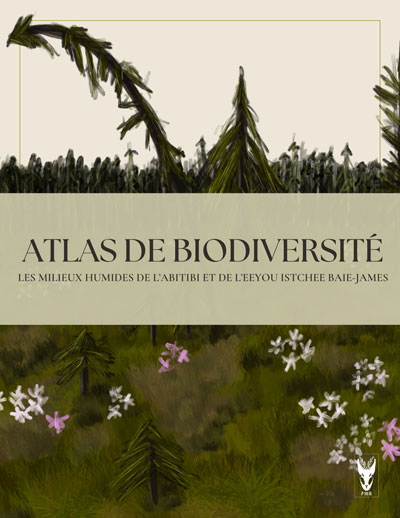
Jacques Brisson
Membre associé
Écologie végétale
Institut de recherche en biologie végétale (IRBV)
Université de Montréal
Jardin Botanique, bureau F340
4101 Sherbrooke Est
Montréal (Québec) Canada, H1X 2B2
(514) 343-2116
FORMATION
- Postdoctorat en écologie végétale, 1996 (Université de Montréal)
- Ph.D. en écologie, 1994 (University of California, Davis et San Diego State University). Directeur : James F. Reynolds
- M.Sc. en sciences biologiques, 1986 (Université de Montréal). Directeur : André Bouchard, codirecteur : Yves Bergeron.
- B.Sc. en sciences biologiques, 1983 (Université de Montréal)
THÈMES DE RECHERCHE
Écologie des populations. Compétition pour l'espace. Maîtrise intégrée de la végétation. Espèces envahissantes. Capacité naturelle d'épuration des eaux par les plantes aquatiques.
Les travaux de recherche du laboratoire de dynamique végétale portent sur l'identification et la quantification des mécanismes de la compétition intra- et inter-spécifique pour l'espace. Sur le plan fondamental, l'objectif poursuivi consiste à intégrer la plasticité de croissance chez les végétaux au phénomène de compétition entre plantes voisines et d'en évaluer les conséquences sur la dynamique végétale. L'expertise acquise par le laboratoire sur la compétition et l'occupation de l'espace par les plantes est mise à profit dans le cadre de travaux de nature appliquée visant à solutionner des problèmes d'ordre environnemental, comme la maîtrise des plantes envahissantes ou l’épuration des eaux usées par l’utilisation de macrophytes à croissance rapide.
Je suis le Président-fondateur de la Société Québécoise de Phytotechnologie ![]() . Je suis également membre du Centre de la science de la biodiversité du Québec
. Je suis également membre du Centre de la science de la biodiversité du Québec ![]() .
.
DISTINCTIONS REÇUES
- Mai 2012 - récipiendaire du Prix d'excellence en enseignement 2012 de l'Université de Montréal
Vous pouvez télécharger toutes mes références bibliographiques en format BibTeX, BibTeX-CSV, FRQNT ou EndNote
PUBLICATIONS
Livres
Aucun
Chapitres de livre
- Saucier, J.-P., Grondin, P., Robitaille, A., Gosselin, J., Morneau, C., Richard, P.J.H., Brisson, J., Sirois, L., Leduc, A., Morin, H. et al. (2009) Écologie forestière. (Chap. 4) In Manuel de foresterie, 2e éd. (Ordre des ingenieurs forestiers du Quebec, Eds.) Québec, Éditions MultiMondes, pages 165-316
- Bouchard, A., Brisson, J. (1996) Domaine de l’érablière à caryer cordiforme. In Manuel de foresterie. (Berard, J.A, Eds.) Les Presses de l’Université Laval, Québec, pages 160-170
Livres, numéros spéciaux et actes de colloques publiés à titre d'éditeur
Aucun
Articles révisés par un comité de lecture
- Couture, A.-A., Deziel, M., Brisson, J., Davidson Jewell, M., Paquette, A. (2025) The effect of biodiversity on productivity changes over time in duckweed communities. Oikos, 2025(7):e11092
- Parasquive, V., Brisson, J., Laliberte, E., Chagnon, P.L. (2024) Limited impact of soil inocula from arbuscular and ectomycorrhizal-dominated sites on root morphology and growth of four tree seedling species from a temperate deciduous forest. Plant and Soil
- Parasquive, V., Brisson, J., Guilbeault-Mayers, X., Laliberte, E., Chagnon, P. (2023) Contrasted root trait responses between saplings of an arbuscular and an ectomycorrhizal tree species in open field compared to forest conditions. Journal of Ecology, 111(8):1700 – 1710
- Dion, P.-P., Brisson, J., Fontaine, B., Lapointe, L. (2016) Light acclimation strategies change from summer green to spring ephemeral as wild-leek plants age. American Journal of Botany, 103(5):963-970
- Rodriguez, M., Brisson, J. (2016) Does the combination of two plant species improve removal efficiency in treatment wetlands? Ecological Engineering, 91:302-309
- Button, M., Rodriguez, M., Brisson, J., Weber, K.P. (2016) Use of two spatially separated plant species alters microbial community function in horizontal subsurface flow constructed wetlands. Ecological Engineering, 92:18-27
- Rodriguez, M., Brisson, J. (2015) Pollutant removal efficiency of native versus exotic common reed (Phragmites australis) in North American treatment wetlands. Ecological Engineering, 74:364-370
- Ladislas, S., Gerente, C., Chazarenc, F., Brisson, J., Andres, Y. (2015) Floating treatment wetlands for heavy metal removal in highway stormwater ponds. Ecological Engineering, 80:85-91
- Charles-Dominique, T., Edelin, C., Bouchard, A., Legendre, P., Brisson, J. (2015) Using intra-individual variation in shrub architecture to explain population cover. Oikos, 124(6):707-716
- Byun, C., de Blois, S., Brisson, J. (2015) Interactions between abiotic constraint, propagule pressure, and biotic resistance regulate plant invasion. Oecologia, 178(1):285-296
- Albert, A., Brisson, J., Belzile, F., Turgeon, J., Lavoie, C. (2015) Strategies for a successful plant invasion: The reproduction of Phragmites australis in north-eastern North America. Journal of Ecology, 103(6):1529-1537
- Lavoie, C., Brisson, J. (2015) Training Environmental Managers to Control Invasive Plants: Acting to Close the Knowing-Doing Gap. Invasive Plant Science and Management, 8(4):430-435
- Mazerolle, M.J., Perez, A., Brisson, J. (2014) Common reed (Phragmites australis) invasion and amphibian distribution in freshwater wetlands. Wetlands Ecology and Management, 22(3):325-340
- Bissegger, S., Rodriguez, M., Brisson, J., Weber, K.P. (2014) Catabolic profiles of microbial communities in relation to plant identity and diversity in free-floating plant treatment wetland mesocosms. Ecological Engineering, 67:190-197
- Duan, B., Paquette, A., Juneau, P., Brisson, J., Fontaine, B., Berninger, F. (2014) Nitrogen resorption in Acer platanoides and Acer saccharum: influence of light exposure and leaf pigmentation. Acta Physiologiae Plantarum, 36(11):3039-3050
- Paradis, A., Bellavance, M.-A., Fontaine, B., Brisson, J. (2014) Interspecific Competition for Space Between Wetland Plants with Clonal Growth. Wetlands, 34(5):1003-1012
- Byun, C., de Blois, S., Brisson, J. (2013) Plant functional group identity and diversity determine biotic resistance to invasion by an exotic grass. Journal of Ecology, 101(1):128-139
- Perez, A., Mazerolle, M.J., Brisson, J. (2013) Effects of exotic common reed (Phragmites australis) on wood frog (Lithobates sylvaticus) tadpole development and food availability. Journal of Freshwater Ecology, 28(2):165-177
- Khedache, Z., Brisson, J., Touffet, J., Nedjraoui, D. (2013) Impact of climate and human activities on the populations of Anabasis arctioides, a Saharan xerophytic plant. Revue d'Ecologie (La Terre et la Vie), 68(2):121-131
- Gagnon, V., Chazarenc, F., Comeau, Y., Brisson, J. (2013) Effect of plant species on sludge dewatering and fate of pollutants in sludge treatment wetlands. Ecological Engineering, 61:593-600
- Albert, A., Brisson, J., Dube, J., Lavoie, C. (2013) Do woody plants prevent the establishment of common reed along highways? insights from southern Quebec. Invasive Plant Science and Management, 6(4):585-592
- Mozdzer, T.J., Brisson, J., Hazelton, E.L.G. (2013) Physiological ecology and functional traits of North American native and Eurasian introduced Phragmites australis lineages. AoB Plants, 5
- Ladislas, S., Gerente, C., Chazarenc, F., Brisson, J., Andreas, Y. (2013) Performances of two macrophytes species in floating treatment wetlands for cadmium, nickel, and zinc removal from urban stormwater runoff. Water, Air, and Soil Pollution, 224(2)
- Paquette, A., Fontaine, B., Berninger, F., Dubois, K., Lechowicz, M.J., Messier, C., Posada, J., Valladares, F., Brisson, J. (2012) Norway maple displays greater seasonal growth and phenotypic plasticity to light than native sugar maple. Tree Physiology, 32(11):1339-1347
- Rodriguez, M., Brisson, J., Rueda, G., Rodriguez, M.S. (2012) Water quality improvement of a reservoir invaded by an exotic macrophyte. Invasive Plant Science and Management, 5(2):290-299
- Lapointe, M., Brisson, J. (2012) A Comparison of Invasive Acer platanoides and Native A. saccharum First-Year Seedlings: Growth, Biomass Distribution and the Influence of Ecological Factors in a Forest Understory. Forests, 3(2):190-206
- Charles-Dominique, T., Edelin, C., Brisson, J., Bouchard, A. (2012) Architectural strategies of Rhamnus cathartica (Rhamnaceae) in relation to canopy openness. Botany, 90(10):976-989
- Gagnon, V., Chazarenc, F., Koiv, M., Brisson, J. (2012) Effect of plant species on water quality at the outlet of a sludge treatment wetland. Water Research, 46(16):5305-5315
- Lavoie, C., Belzile, F., Brisson, J., De Blois, S., Dumont, P., Gauthier, G., Hatin, D., Mazerolle, M.J., Morin, J. (2012) Le roseau envahisseur: la dynamique, l'impact et le contrôle d'une invasion d'envergure. Le Naturaliste canadien, 136:33-39
- Messier, C., Belanger, N., Brisson, J., Lechowicz, M.J., Gravel, D. (2011) Comment on "Present-day expansion of American beech in northeastern hardwood forests: Does soil base status matter?". Canadian Journal of Forest Research, 41(3):649-653
- Lapointe, M., Brisson, J. (2011) Tar spot disease on norway maple in North America: Quantifying the impacts of a reunion between an invasive tree species and its adventive natural enemy in an urban forest. Ecoscience, 18(1):63-69
- Fillion, M., Brisson, J., Guidi, W., Labrecque, M. (2011) Increasing phosphorus removal in willow and poplar vegetation filters using arbuscular mycorrhizal fungi. Ecological Engineering, 37(2):199-205
- Paquette, A., Fontaine, B., Messier, C., Brisson, J. (2010) Homogeneous light in shade-house experiment overestimates carbon gains in tree seedlings. Journal of Horticulture and Forestry, 2(6):117-121
- Chazarenc, F., Naylor, S., Comeau, Y., Merlin, G., Brisson, J. (2010) Modeling the effect of plants and peat on evapotranspiration in constructed wetlands. International Journal of Chemical Engineering, 2010(Article ID 412734):6
- Bellavance, M.-E., Brisson, J. (2010) Spatial dynamics and morphological plasticity of common reed (Phragmites australis) and cattails (Typha sp.) in freshwater marshes and roadside ditches. Aquatic Botany, 93(2):129-134
- Chazarenc, F., Brisson, J., Merlin, G. (2010) Seasonal and spatial changes of microorganism communities in constructed wetlands: A community level physiological profiling analysis. International Journal of Chemical Engineering, 2010(Article ID 490240):6
- Tousignant, M.-E., Pellerin, S., Brisson, J. (2010) The relative impact of human disturbances on the vegetation of a large wetland complex. Wetlands, 30(2):333-344
- Chazarenc, F., Filiatrault, M., Brisson, J., Comeau, Y. (2010) Combination of Slag, Limestone and Sedimentary Apatite in Columns for Phosphorus Removal from Sludge Fish Farm Effluents. Water, 2(3):500-509
- Gagnon, V., Maltais-Landry, G., Puigagut, J., Chazarenc, F., Brisson, J. (2010) Treatment of hydroponics wastewater using constructed wetlands in winter conditions. Water, Air, and Soil Pollution, 212(1-4):483-490
- Messier, C., Coll, L., Poitras-Lariviere, A., Belanger, N., Brisson, J. (2009) Resource and non-resource root competition effects of grasses on early- versus late-successional trees. Journal of Ecology, 97(3):548-554
- Maltais-Landry, G., Maranger, R., Brisson, J., Chazarenc, F. (2009) Nitrogen transformations and retention in planted and artificially aerated constructed wetlands. Water Research, 43(2):535-545
- Maltais-Landry, G., Maranger, R., Brisson, J., Chazarenc, F. (2009) Greenhouse gas production and efficiency of planted and artificially aerated constructed wetlands. Environmental Pollution, 157(3):748-754
- Maltais-Landry, G., Maranger, R., Brisson, J. (2009) Effect of artificial aeration and macrophyte species on nitrogen cycling and gas flux in constructed wetlands. Ecological Engineering, 35(2):221-229
- Brisson, J., Chazarenc, F. (2009) Maximizing pollutant removal in constructed wetlands: Should we pay more attention to macrophyte species selection? Science of the Total Environment, 407(13):3923-3930
- Faulwetter, J.L., Gagnon, V., Sundberg, C., Chazarenc, F., Burr, M.D., Brisson, J., Camper, A.K., Stein, O.R. (2009) Microbial processes influencing performance of treatment wetlands: A review. Ecological Engineering, 35(6):987-1004
- Chazarenc, F., Gagnon, V., Comeau, Y., Brisson, J. (2009) Effect of plant and artificial aeration on solids accumulation and biological activities in constructed wetlands. Ecological Engineering, 35(6):1005-1010
- Fillion, M., Brisson, J., Teodorescu, T.I., Sauve, S., Labrecque, M. (2009) Performance of Salix viminalis and Populus nigra × Populus maximowiczii in short rotation intensive culture under high irrigation. Biomass and Bioenergy, 33(9):1271-1277
- Brisson, J., Paradis, E., Bellavance, M.E. (2008) Evidence of sexual reproduction in the invasive common reed (Phragmites Australis subsp Australis; Poaceae) in eastern Canada: A possible consequence of global warming? Rhodora, 110(942):225-230
- Paquette, A., Laliberte, E., Bouchard, A., De Blois, S., Legendre, P., Brisson, J. (2007) Lac Croche understory vegetation data set (1998-2006): Ecological Archives E088-197. Ecology, 88(12):3209
- Maltais-Landry, G., Chazarenc, F., Comeau, Y., Troesch, S., Brisson, J. (2007) Effects of artificial aeration, macrophyte species, and loading rate on removal efficiency in constructed wetland mesocosms treating fish farm wastewater. Journal of Environmental Engineering and Science, 6(4):409-414
- Beaudet, M., Brisson, J., Gravel, D., Messier, C. (2007) Effect of a major canopy disturbance on the coexistence of Acer saccharum and Fagus grandifolia in the understorey of an old-growth forest. Journal of Ecology, 95:458-467
- Beaudet, M., Brisson, J., Messier, C., Gravel, D. (2007) Effect of a major ice storm on understory light conditions in an old-growth Acer-Fagus forest: Pattern of recovery over seven years. Forest Ecology and Management, 242(2-3):553-557
- Chazarenc, F., Maltais-Landry, G., Troesch, S., Comeau, Y., Brisson, J. (2007) Effect of loading rate on performance of constructed wetlands treating an anaerobic supernatant. Water Science and Technology, 56(3):23-29
- Chazarenc, F., Brisson, J., Comeau, Y. (2007) Slag columns for upgrading phosphorus removal from constructed wetland effluents. Water Science and Technology, 56(3):109-115
- Gagnon, V., Chazarenc, F., Comeau, Y., Brisson, J. (2007) Influence of macrophyte species on microbial density and activity in constructed wetlands. Water Science and Technology, 56(3):249-254
- Brisson, J., Cogliastro, A., Robert, M. (2006) Controlling speckled alder (Alnus incana ssp. rugosa) invasion in a wetland reserve of Southern Quebec. Natural Areas Journal, 26(1):78-83
- Ouellet-Plamondon, C., Chazarenc, F., Comeau, Y., Brisson, J. (2006) Artificial aeration to increase pollutant removal efficiency of constructed wetlands in cold climate. Ecological Engineering, 27(3):258-264
- de Blois, S., Brisson, J., Bouchard, A. (2004) Herbaceous covers to control tree invasion in rights-of-way: Ecological concepts and applications. Environmental Management, 33(5):606-619
- Brisson, J. (2004) Forked three-awned grass, Aristida basiramea Engelm. ex Vasey: A new addition to the flora of Quebec. The Canadian Field-Naturalist, 118(2):276-277
- Naylor, S., Brisson, J., Labelle, M. A., Drizo, A., Comeau, Y. (2003) Treatment of freshwater fish farm effluent using constructed wetlands: The role of plants and substrate. Water Science and Technology, 48(5):215-222
- Villeneuve, N., Brisson, J. (2003) Old-growth forests in the temperate deciduous zone of Quebec: Identification and evaluation for conservation and research purposes. Forestry Chronicle, 79(3):559-569
- Brisson, J., Bouchard, A. (2003) In the past two centuries, human activities have caused major changes in the tree species composition of southern Quebec, Canada. Ecoscience, 10(2):236-246
- Le Guerrier, C., Marceau, D.J., Bouchard, A., Brisson, J. (2003) A modelling approach to assess the long-term impact of beech bark disease in northern hardwood forest. Canadian Journal of Forest Research, 33(12):2416-2425
- Vujanovic, V., Brisson, J. (2002) Microfungal biodiversity on Fagus grandifolia in an old-growth forest of Eastern North-America. Phyton - Annales Rei Botanicae, 42(2):315-327
- Comeau, Y., Brisson, J., Reville, J.P., Forget, C., Drizo, A. (2001) Phosphorus removal from trout farm effluents by constructed wetlands. Water Science and Technology, 44(11-12):55-60
- Mercier, C., Brisson, J., Bouchard, A. (2001) Demographic analysis of tree colonization in a 20-year-old right-of-way. Environmental Management, 28(6):777-787
- Brisson, J. (2001) Neighborhood competition and crown asymmetry in Acer saccharum. Canadian Journal of Forest Research, 31(12):2151-2159
- Tardif, J.C., Brisson, J., Bergeron, Y. (2001) Dendroclimatic analysis of Acer saccharum, Fagus grandifolia, and Tsuga canadensis from an old-growth forest, southwestern Quebec. Canadian Journal of Forest Research, 31(9):1491-1501
- Vujanovic, V., Brisson, J. (2001) The microfungal biodiversity of Fagus grandifolia in an old forest: Bioindicators and mycosociologic structure. The Canadian Field-Naturalist, 115(1):34-42
- Vujanovic, V., St-Arnaud, M., Neumann, P., Fortin, J.A., Brisson, J. (1999) A new species Polynema muirii on Fagus grandifolia. Mycologia, 91(1):136-140
- Beaudet, M., Messier, C., Pare, D., Brisson, J., Bergeron, Y. (1999) Possible mechanisms of sugar maple regeneration failure and replacement by beech in the Boise-des-Muir old-growth forest, Quebec. Ecoscience, 6(2):264-271
- Laouali, G., Brisson, J., Dumont, L., Vincent, G. (1998) Nitrogen and phosphorus removal in a subsurface-flow reed bed. Water Quality Research Journal of Canada, 33(2):319-329
- Brisson, J., Reynolds, J.F. (1997) Effects of compensatory growth on population processes: A simulation study. Ecology, 78(8):2378-2384
- Meilleur, A., Brisson, J., Bouchard, A. (1997) Ecological analyses of the northernmost population of pitch pine (Pinus rigida). Canadian Journal of Forest Research, 27(9):1342-1350
- Brisson, J., Bergeron, Y., Bouchard, A., Leduc, A. (1994) Beech-maple dynamics in an old-growth forest in southern Quebec, Canada. Ecoscience, 1(1):40-46
- Brisson, J., Reynolds, J.F. (1994) The effect of neighbors on root distribution in a creosotebush (Larrea tridentata) population. Ecology, 75(6):1693-1702
- Brisson, J., Bergeron, Y., Bouchard, A. (1988) Les successions secondaires sur sites mesiques dans le Haut-Saint- Laurent, Quebec, Canada. (Secondary succession on mesic sites in the upper St. Lawrence River, Quebec, Canada). Canadian Journal of Botany, 66(6):1192-1203
Articles publiés dans des actes de colloque (proceedings)
- Chazarenc, F., Gagnon, V., Comeau, Y., Brisson, J. (2007) Biofilm accumulation and activity in constructed wetland : efffect of artificial aeration and plant species. In 2nd International Symposium on wetland pollutant dynamics and control, WETPOL 2007.. (Mander, U., Koiv, M. and Vohla, C., Eds.) Inst. Geogr. Universitatis Tartuensis, pages 67-69
- Brisson, J., Chazarenc, F. (2006) Pollutant removal in subsurface constructed wetlands: should we pay more attention to macrophyte species selection? In 10th International conference on wetland systems for pollution control.. Pages 909-917
- Brisson, J., Meilleur, A., Fortin, M.-J., Bouchard, A. (1997) Edge effects on vegetation in rights-of-way. In Environmental Concerns in Rights-of-Way Management.. Elsevier Science, pages 25-33
Rapports scientifiques, manuels et autres
- Levesque, S., Demers, E., Comeau, Y., Brisson, J. (2016) Efficacité des approches de phytotraitement par marais filtrant à l’essai sur le site de la cour d'entreposage de Laval. Technical report, Institut de recherche en biologie végétale
- Karathanos, S., Boivin, P., Brisson, J. (2015) Expérimentation de méthodes de contrôle hivernal de l’Aulne rugueux pour favoriser le maintien d’habitats de qualité du Râle jaune et du Troglodyte à bec court à la réserve nationale de faune du Lac-Saint-François (RNFLSF). Technical report, Institut de recherche en biologie végétale
- Boivin, P., Brisson, J. (2015) Berce du Caucase : stratégies de lutte pour un nouvel envahisseur en terres agricoles. Technical report, Institut de recherche en biologie végétale
- Boivin, P., Brisson, J., de Blois, S., Fontaine, B., Bouchard, A. (2008) Maîtrise intégrée de la végétation de la ligne Hertel – Des Cantons: projets réalisés dans le cadre du suivi écologique, des ensemencements de mélanges stables et de la maîtrise des rejets des souches et des drageons. Activités 2008. Technical report, Institut de recherche en biologie végétale.
- Boivin, P., Brisson, J. (2008) Plantation de haies arbustives pour contrer l’invasion par le roseau commun : Protocole d’implantation de haies expérimentales aux abords de l’autoroute 50, à Fassett. Technical report, Institut de recherche en biologie végétale, Montréal.
- Midy, J., Boivin, P., Brisson, J. (2007) Invasion du Parc du Mont-Royal par l’érable de Norvège : évaluation de la situation, causes et conséquences. Rapport préparé pour la Direction des sports, des parcs et des espaces verts, Ville de Montréal., Institut de recherche en biologie végétale.
- Boivin, P., Brisson, J., de Blois, S., Fontaine, B., Bouchard, A. (2007) Maîtrise intégrée de la végétation dans la ligne Hertel – des Cantons. Volet 1 : Suivi écologique; Volet II : Ensemencement de mélanges herbacés stables; Volet III : Maîtrise des rejets de souches et des drageons. Rapport préparé pour Hydro-Québec, TransÉnergie, Institut de recherche en biologie végétale, Montréal
- Boivin, P., Brisson, J., Bouchard, A. (2006) Maîtrise intégrée de la végétation de la ligne Hertel – Des Cantons: projets réalisés dans le cadre du suivi écologique, des ensemencements de mélanges stables et de maîtrise des rejets des souches et des drageons. Rapport préparé pour Hydro-Québec, TransÉnergie., Institut de recherche en biologie végétale
Thèses, mémoires et essais
- Brisson, J. (1994) Growth plasticity and neighborhood interactions with special reference to creosotebush (Larrea tridentata). Thèse de doctorat, University of California, Davis / San Diego State University
- Brisson, J. (1986) Successions forestières sur sites mésiques dans la MRC du Haut-Saint-Laurent. Mémoire de maîtrise, Université de Montréal
Thèses, mémoires et essais supervisés
- Couture, A.A. (2022) L'effet de la diversité sur la productivité des communautés végétales change-t-il avec le temps? Une étude basée sur un modèle expérimental simplifié. Mémoire de maîtrise, Université du Québec à Montréal
- Tousignant, M.-E. (2009) Impact des perturbations anthropiques sur la végétation du complexe de milieux humides des Tourbières-de-Lanoraie. Mémoire de maîtrise, Université de Montréal
- Lapointe, M. (2009) Les facteurs écologiques influençant la dynamique d'une espèce exotique envahissante, Acer platanoides, et d'un congénère indigène, A. saccharum, dans une forêt urbaine du sud du Québec. Mémoire de maîtrise, Université de Montréal
- Fillion, M. (2007) Épuration d'un effluent piscicole par l'irrigation intensive d'une plantation d'arbres à croissance rapide. Mémoire de maîtrise, Université de Montréal
- Fontaine, B. (2006) Facteurs écologiques responsables de l’envahissement par les arbres de la végétation des emprises de transport d’électricité. Mémoire de maîtrise, Université de Montréal
Articles non révisés par un comité de lecture
- Brisson, J., Lemieux-Bibeau, D. (2010) Le platane occidental : nouvelle espèce d’arbre indigène au Québec? Quatre-Temps, 34(2):42-44
- Brisson, J. (2006) L’érable à sucre : un emblème malmené. Quatre-Temps, 30(4):3-5
- Brisson, J., Bouchard, A. (2006) The Haut-Saint-Laurent wilderness at the time of settlement based on Sellar’s History. Part II : Forests and wetlands. Chateauguay Valley Historical Society Annual Journal
- Brisson, J. (2006) Un rare vestige du passé au cœur d’un territoire agricole : Le Boisé-des-Muir. Cap-aux-Diamants (Revue d’Histoire du Québec)., 86:33-35










